Larry Polansky on James Tenney
A Few Words about Jim Tenney
Larry Polansky
10/10/061.
Our sadness at Jim Tenney’s passing is combined with the awareness that there is now a hole in the planet. Jim deeply understood something many of us have trouble with — that there are things “out there” that deserve our serious attention. Music, ideas, beautiful work, friendship, even the fate of the human race and the current status of the cosmos — these things equally concerned and impassioned him. And when Jim gave something serious attention, he was, well, serious about it. He cared and thought deeply about what we always hope there will be time to care and think deeply about. He appeared to do that each day of his life, every hour of every day. This was his nature.2.
In my opinion, Jim Tenney was the most important and brilliant composer/theorist of the second half of the twentieth century. I usually avoid statements like that: they’re by definition fatuous, and it’s not a competition. But for Jim I’ll make an exception. After Cage, no other composer so elegantly and beautifully integrated ideas and music. No one else’s work, as a whole, is as profound, experimental, wide-ranging, accomplished, or revolutionary.Jim wrote more text than most people realize. Starting with Meta + Hodos and the computer music articles of the early 1960s; through his work on “timbre,” pitch, and other composers in the late 1960s and early 1970s; his theoretical articles of the late 1970s (like the few but brilliant essays in Perspectives… and the Journal of Music Theory); and culminating with his wide-ranging work on pitch-space, intonation, and perception in the last 25 years, he left an almost immeasurably broad and important theoretical, aesthetic, intellectual and musical corpus. His writing is poorly acknowledged, not widely read, and almost completely misunderstood. In addition, it’s mostly unavailable — he intentionally placed much of it in small, non-academic publications.
His ideas delineate and explore the most important musical ideas of the past 50 years: form, perception, timbre, harmony, and the nature of the compositional process. When I teach courses in advanced musical theory, I sometimes have to force myself to use writings by other theorists – not much other work seems quite as interesting, relevant or important as Jim’s. He wrote and thought about elementals: form, pitch, cognition and perception (among other things).
He meant things in a way that few others do, and we should take a lesson from him in this. He cared little (in fact, not at all) for academic or intellectual fashion. He was singularly focused on getting it right. He wanted to know how the ear, the brain, and music worked (and might work). He was among the first (if not the first) theorist (and composer) to focus on ideas like the examination of deep musical processes irrespective of style, the use of cognition and perception as the basis for music theory, and a phenomenological understanding of our musical perception. His investigations began at a much deeper level than what passes for music theory (even today). I think we should revise our definition: whatever Jim Tenney did, and however he did it, is music theory.
Jim never advanced an idea until he was convinced he could win an argument about it with himself. His discussions were deep, brutal, and lengthy, with the most exacting person he could find (himself). Sometimes he checked in with a few others lucky enough to have earned a bit of his confidence, but by then it was unlikely that anyone else could help much. He did so much homework, and thought so hard, that there was rarely a new idea, technique, or avenue he hadn’t already considered and probably discarded.
3.
All his life, Jim taught. As a teacher, he avoided the remedial. He had little interest in, time (nor, I think, aptitude) for that kind of pedagogy. As a theorist and composer, he had things to say and investigate. He pursued ideas at a depth that was usually intimidating, often a bit scary, always exciting. His teaching sprang from these investigations, and he taught at a very high level, not some imagined least common denominator. Jim believed, and acted upon the assumption that the academy was a place of ideas, of search — an intellectual and artistic eden where everyone was more or less like him!Jim was a throwback: an artist and thinker whose love for teaching emanated directly and completely from a love for ideas. He was happiest when describing some new insight he’d had about harmonic space, gestalt segregation, fundamental perception, the octave, Webern, cacti. His love of art, the world and ideas was unfettered. I’ve encountered a very few people like that in my life, and one of the saddest things about his passing is that now there’s one fewer.
4.
I always suspected that some deranged gods had granted Jim the gift of eight extra clandestine hours a day to work, during which he calmly entered an alternate dimension, read twenty books and articles (maybe in Latin or German, languages he taught himself as he was doing research), filled up several of his ubiquitous graph-paper pads, and returned to the corporeal plane with what he needed.5.
Reverent of history, Jim enjoyed it immensely, and was in it. He taught (maybe “taught” is the wrong word: he inspired) his students to share his respect and fascination for so many traditions, and to consider them alive. He showed us that history was fluid, incomplete, not over: there was work to be done. Schoenberg, Ruggles, Partch, Satie, Varèse, Nancarrow, Cage, and Crawford Seeger (even, at various times in his life, Wagner!) were his colleagues.Jim’s immediate musical family consisted of composers of the past, present, and future. He understood, collaborated, and conversed with all at great length, built on their ideas the way a scientist does. He never, ever disrespected them. They dwelled in his musical house along with the rest of us. One learned from Jim how precisely and seriously to cherish other composers, and all other artists, because he was so careful, sincere, and active about it. He gave great credence to the making of art and the life of the idea — everyone who at was at least nominally a fellow traveler got the benefit of the doubt, often more than we perhaps deserved.
6.
In Meta + Hodos, and his later writings, Jim redesigned the architecture of twentieth century music theory. In the
Bell Labs pieces (like Phases, Ergodos, Noise Study), he invented fundamental techniques for using computers as compositional tools (creating the idea of a compositional subroutine for synthesis environments). He freely moved between “art” and “science,” applying his engineering acuity and musical vision to some of the philosophical insights he gained from his close association with Cage (and Varèse).He sought connections, and had no patience for arbitrary distinctions. I don’t think it ever occurred to Jim that emotion, intellect, spirituality, science, harmony, creativity, knowledge, curiosity were all that different. Nor should they be parsimoniously doled out in support of some strategic artistic agenda. They were all part of being human, and an artist. His epiphanies often emerged as marriages of ideas, what he called “bridges.” He sought and found the profound connections between the work of Hiller, Partch, Cage, Varèse and others. He created new species from these breeding pairs — not hybrids, but fertile new organisms that reproduced again and again, evolving with each generation.
Jim’s ideas were startling in their originality and scope, but because they were great ideas, they had precursors. Each piece led and could be traced to other pieces, and always to some fundamental idea. Somewhere, somehow, Harry Partch led to Quintexts which led to Diapason and eventually to his final string quartet, Arbor Vitae (which the young composer Michael Winter helped him finish near the end of his life).
Jim was intensely curious, but not restless. He asked, “What’s next?” not because he was bored, but because he was hard-wired for forward motion. He remained in perpetual morphogenesis (to borrow a term roughly meaning “evolving and changing in shape,” from one of his favorite writers, D’Arcy Thompson) until the end. The morphogenesis of his ideas won’t stop because he did: it will increase in strength like some kind of electro-magnetic resonance — steadily and exponentially.
7.
Over the years, one of my greatest pleasures was listening to Jim describe seemingly fantastic theoretical speculations, some a little too strange to talk about publicly, semi-cosmic ideas reserved for close friends, late at night. Yet even the wackiest of these (his word, not mine) seemed somehow believable. They were modulated by his intelligence and refined in the crucible of his impatience with “just making stuff up!” I always expect to pick up the New York Times Science section some Tuesday morning and read the headline: “James Tenney’s conjecture about the cosmos verified by experimental result!”8.
The homes that Jim and Lauren Pratt made over the past 20 years — whether in New York City, California, Toronto, or Berlin —were always full. They were places where art and ideas were welcome, there was no need for pretense, and there was all the time in the world. Careerism, gossip, gig-talk, pettiness and the like seemed inappropriate. His home was a haven for art — a safe and necessary respite from the quotidian. Anyone and everyone was welcomed: his and Lauren’s idea of the “open house” (in Toronto) was among the most brilliant ideas he was ever involved in.He listened with a singular intensity, imbued personal relationships with deep gravity. You always felt that he considered you essential, somehow, to the well being of the planet. You walked in to his and Lauren’s home, a beer appeared in your hand, and all of a sudden your life, at least for the next few hours, was really about music.
9.
Like Cage, Partch, Varèse, Hiller, Harrison, Ruggles, and some of the other composers of his genus, Jim dealt with large ideas, systems of thought, “embodiments of mind” (a phrase from another of his favorite authors, Warren McCullough, whose work he was revisiting the last time I spoke to him). His writings provide the foundation for a remarkable edifice that we will spend a long time completing.For me, though, much of the joy in remembering Jim emanates from small, often very practical notions, which seemed to arise almost incidentally, like wildflowers. These musical and theoretical “volunteers” delighted him as much as anything in his life, but he rarely talked about them, except among friends. I think he thought of this stuff as part and parcel of being a composer. When he’d casually show you something like this, his tremendous glee in solving some “smaller” compositional or theoretical dilemma was evident. He’d get a particular kind of grin on his face, like he’d just solved a riddle rather than proved a theorem.
All of this is in the music, sometimes deeply embedded, sometimes immediately apparent. I remember the moment the compositional idea of Chorales for Orchestra clarified itself to me: the vertical was the horizontal; each was the primes of the harmonic series in a crypto-palindromic-Jim-homage to the music of Ives, Stravinsky and Ruggles — and who knows what else!? Understanding Jim’s techniques reduced you to a kind of dumb, teenage-inflected “how cool is that?” grin, wishing you’d thought of it yourself.
He seldom published or formally described these intermediate compositional ideas. Nor were they premeditated: he created them as he went along; necessary pieces to some larger, cosmic-musical puzzle he was forever trying to solve. It was as if while busy inventing the wheel: at some point he realized he needed to come up with the idea of a spoke, but didn’t think it important enough to mention! It reminded me of the way brilliant mathematicians sometimes invent entirely new branches of mathematics en route to solving a theorem. Jim contributed new concepts with nearly every piece.
These ideas give a sense of Jim’s playfulness and deep commitment to compositional craft, something I think that is often overlooked when his work is discussed. I believe that craft was the most important thing to him, but his conception of it was unique. He loved music too much to exploit it, enslave it to his own ends. His mode of expression was not the liberation of himself but of other things — ideas and sound — which he neither hamstrung to ordinary expectation, nor indentured to “success.”
In a world increasingly obsessed with the super-saturation of the immediate, Jim took a different approach. In the early 1960s he was close to the great experimental psychologist Roger Shepard, who pioneered a powerful technique called multi-dimensional scaling (MDS) which allows a set of complex multi-variable differences between even unrelated objects or concepts to be viewed in a simpler space, like the plane. An MDS plot of the way a group of listeners perceive differences between sonic events can illustrate what the most important “dimensions of similarity” might be. One of the most fascinating concepts associated with MDS is the idea of stress. If the mathematical reduction of the complexity of some perceptual space produces too great a stress, it means that the picture we’re looking at isn’t reliable, that there are too many important dimensions: the fit is very bad. In this case, the MDS algorithm automatically adds a dimension (from line to plane to 3-space, etc.) so that the sets of differences will fit more comfortably, be more meaningful. Jim consciously integrated this idea into several pieces (like Changes), in which the prime dimensionality of harmonic space was increased when things got too “ambiguous” at the “next lower dimension.
”But I think this is a deeper metaphor for Jim’s work. I often feel that more and more, composers (and regrettably the rest of society) have become like what mathematicians call fractals, functions which are extremely complicated, but in a low dimensionality. We have so much information readily at hand, things move so quickly, decisions are made with such immediacy, that depth, ambiguity, taking time to explore ideas is not generally tolerated, much less encouraged. Music is judged quickly, often after being heard just once! Jim’s music inhabits a very different world. His ideas are of sufficient richness to be forced into higher dimensions, and require more complex perceptual and aesthetic geometries.
10.
In recent years Jim’s work received far more attention than it had over the previous thirty years. But this was not his goal. As a point of honor, a measure of integrity, he sought far less attention than he deserved. He made sure, though, that when someone did pay attention, they would be rewarded by what was heard. Maybe Jim thought that it was, in some literal way, good to leave the world in one’s debt, and not vice versa. He did.11.
Many of our conversations over the years had little to do with music. In Toronto, late at night, Jim would pull out a graph-paper pad on which he’d been working out some odd idea. One night, I think, he showed me a kind of universal theory of matter that he was considering. He was trying, in his own way, and by the sheer power of his own deduction and instinct, to explain “everything,” at least to himself. I remember nothing of the content of that graph-paper pad, but what I clearly recall was that somewhere near the end, he said to me, with great seriousness, that he’d very much like to be remembered as a “composer and amateur cosmologist.” That is, in fact, how I remember him.(Coda)
A few days before Jim died, in the hours after which he finally lost consciousness, something odd happened at home here in New Hampshire, three thousand miles away.Early that morning we came outside to find a Great Blue Heron perched on top of our red minivan. I stood with neighbors for nearly an hour, watching as the large bird made itself at home. The theory was that construction on a small bridge over the Mink Brook, just a few yards away from our house, had disturbed his nest.
When I learned the chronology of his final days from Lauren, I realized the coincidence and thought: “That’s just the kind of thing Jim would do!,” and was glad that my old friend stopped in to say goodbye.
But maybe Jim didn’t pull off that stunt entirely on his own. Perhaps the cosmos, being so firmly in his debt, was paying him back a little.
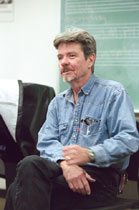

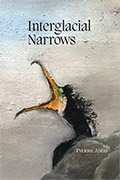 “Interglacial Narrows (Poems 1915-2021)” Contra Mundum Press
“Interglacial Narrows (Poems 1915-2021)” Contra Mundum Press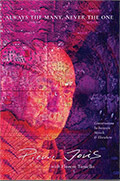 “Always the Many, Never the One: Conversations In-between, with Florent Toniello” Contra Mundum Press
“Always the Many, Never the One: Conversations In-between, with Florent Toniello” Contra Mundum Press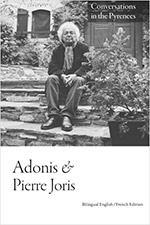 “Conversations in the Pyrenees”
“Conversations in the Pyrenees”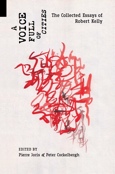 “A Voice Full of Cities: The Collected Essays of Robert Kelly.” Edited by Pierre Joris & Peter Cockelbergh
“A Voice Full of Cities: The Collected Essays of Robert Kelly.” Edited by Pierre Joris & Peter Cockelbergh “An American Suite” (Poems) —Inpatient Press
“An American Suite” (Poems) —Inpatient Press “Arabia (not so) Deserta” : Essays on Maghrebi & Mashreqi Writing & Culture
“Arabia (not so) Deserta” : Essays on Maghrebi & Mashreqi Writing & Culture “Barzakh” (Poems 2000-2012)
“Barzakh” (Poems 2000-2012) “Fox-trails, -tales & -trots”
“Fox-trails, -tales & -trots”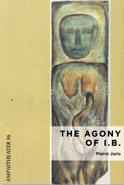 “The Agony of I.B.” — A play. Editions PHI & TNL 2016
“The Agony of I.B.” — A play. Editions PHI & TNL 2016 “The Book of U / Le livre des cormorans”
“The Book of U / Le livre des cormorans”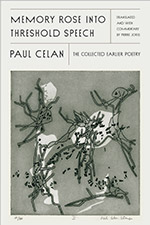 “Memory Rose Into Threshold Speech: The Collected Earlier Poetry of Paul Celan”
“Memory Rose Into Threshold Speech: The Collected Earlier Poetry of Paul Celan”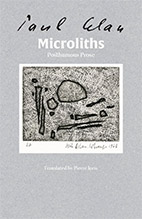 “Paul Celan, Microliths They Are, Little Stones”
“Paul Celan, Microliths They Are, Little Stones”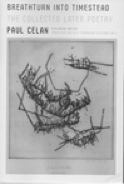 “Paul Celan: Breathturn into Timestead-The Collected Later Poetry.” Translated & with commentary by Pierre Joris. Farrar, Straus & Giroux
“Paul Celan: Breathturn into Timestead-The Collected Later Poetry.” Translated & with commentary by Pierre Joris. Farrar, Straus & Giroux